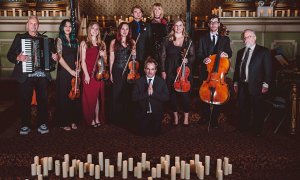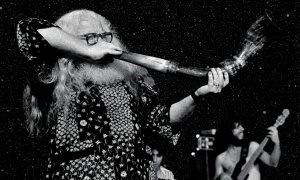Home » Jazz Articles » From the Inside Out » Requiems, Remodels & Remembrances
Requiems, Remodels & Remembrances
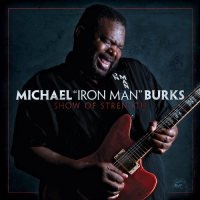
Michael Burks
Show of Strength
Alligator Records
2012
Michael "Iron Man" Burks grew up playing guitar. A quick study, he soon began leading the blues, rhythm and blues and soul house bands that backed O.V. Wright, Johnnie Taylor and other stars as they passed through the R&B circuit near his Arkansas hometown. Then, Burks put his own career aside for two decades to make sure his daughter had an attentive, responsive father.
Burks resurfaced as a "40 year old newcomer" with his self-produced debut From the Inside Out (Vent Records, 1999). Fame and good fortune were soon to follow: Burks signed with Alligator Records, one of Chicago's flagship blues labels, for whom he debuted with the highly acclaimed Make It Rain in 2001. He won the 2004 Living Blues Critics Award for Best Guitarist, and was nominated as 2012 Guitarist of the Year by the Blues Music Awards.
His fourth Alligator release, Show of Strength features more of Burks' original music than any of his previous albums and features his longstanding band: Bassist Terry Grayson, drummer Chuck Louden and keyboardist Wayne Sharp. Without exaggeration, it also moves him into some exquisite company: Blues guitarists who were just as powerful and soulful as vocalists, a pretty exclusive little neighborhood that includes Little Milton Campbell, Eric Clapton, Albert King and Jimi Hendrix but not too many others.
Burks finds profound power and depth in the simple folds of the blues form. His guitar's sprawling, squalling sound in the opening "Count on You" screams out the impact that Hendrix has on just about every blues guitarist since the late 1960s, and "Cross Eyed Woman," six minutes of aural hell, conjures all the menace of the Band of Gypsies, Hendrix' famous electric voodoo trio. Burks rides the beats of the rolling and tumbling "What Does It Take to Please You" and flat-out funny "Can You Read Between the Lines" with King's wide and friendly grin, and it's not much of a stretch to imagine Clapton whipping through "Storm Warning" and "I Want to Get You Back."
The "24 Hour Blues" is sharply produced so the snare drum pops and the electric guitar genuinely screams with pain and anger. No more or less than the honest sound of a man's blood, sweat and tears, "Since I Been Loving You" encapsulates the fury and glory of a man's lifetime, poured out in eight majestic minutes.
Tragically, it also writes Burks' own brilliant epitaph. Show of Strength proved to be the ultimate statement by the blues guitarist and vocalist known as "Iron Man": He finished recording it in April 2012 and then departed for a tour of Europe, leaving producer and Alligator impresario Bruce Iglauer to finish some mixes and sequencing. In May 2012, Burks collapsed and died in the Atlanta airport on his way back home from this European tour. He was 54.
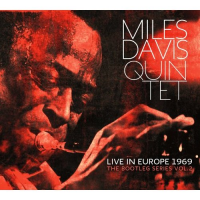
Miles Davis
The Miles Davis Quintet—Live in Europe 1969: The Bootleg Series Vol. 2
Columbia/Legacy
2013
Volume 2 in Legacy's Bootleg Series features Miles Davis' "great lost band" with saxophonist Wayne Shorter, keyboardist Chick Corea, bassist Dave Holland and drummer Jack DeJohnette, recorded in July and November 1969. This band, sometimes called Davis' "third great quintet," never recorded as a standalone ensemble, although it served as the core of the larger group that consolidated around the trumpeter's landmark Bitches Brew sessions in August '69.
While preparing Miles: The Autobiography, Davis told biographer Quincy Troupe: "After we finished In a Silent Way, I took the band out on the road: Wayne, Dave, Chick and Jack DeJohnette were now my working band. Man, I wish this band had been recorded live because it was really a bad motherfucker. I think Chick Corea and a few other people recorded some of our performances live, but Columbia missed out on the whole fucking thing."
Live in Europe 1969 presents three CDs of live recordings—two shows from the Antibes (France) Jazz Festival in July plus a November performance in Stockholm (Sweden)—and a color DVD of a November performance in Berlin (Germany). These performances were bookended by the releases of the studio albums In a Silent Way (released in July '69) and Bitches Brew (April 1970). In fact, "Miles Runs the Voodoo Down" and "Spanish Key" were performed onstage in France (in July) before their studio versions were recorded for Bitches Brew (in August).
Although Davis is undeniably the star, Corea and Holland prove indispensable in this music. Corea's change from acoustic to electric piano irreversibly altered the trajectory of Davis' sound; a source of constant rhythmic and harmonic motion, Holland's bass seems to never stand still and yet its solid foundation never seems to move, either. Interviewed for these liner notes, Holland can now explain: "It's not just about one musician having a single idea and having everybody do it, pulling the strings. It's about taking a group and thinking about what its strengths are and what its direction and tendencies are, and using that. You don't try to change the course of the river. You just try and go with the flow of it and use that flow in a way that will carry the music along."
Holland and DeJohnette kick off "Miles Runs the Voodoo Down," which appears on both Antibes sets, with a monstrous downbeat that wobbles and groans with deep blue funk, and the instrumental vamp dives into an even deeper groove when Corea's electric piano chimes in. Davis' style sounds equidistant between jazz and rock as he spits and splatters flurries of color. In Stockholm, DeJohnette rustles his drums in the acoustic jungle of "Bitches Brew" behind Davis, whose sharp trumpet notes float like ghosts as they duel with the drummer's swirling rhythms, a remarkable document of Davis' style at the time.
Shorter's growing impact on the band's repertoire is evident from the frequent appearance of his polar opposites "Masqualero" and "Sanctuary." Both versions of "Masqualero" sound like they were shot from cannons, with Davis and the other musicians circling 'round DeJohnette's rippling thunder before careening into separate but parallel directions. "Sanctuary" closes both Paris shows as well as the Berlin DVD with Shorter and Davis floating in harmony and then pulling Corea and the rhythm section into their swirling sound cloud, a mellowing that somehow lays the genuine ferocity of this music to rest.
At this juncture, Davis had not left most of his musical past behind—yet—so these set lists included other significant mileposts such as the ironic blues jaunt "No Blues" (first captured Live at the Blackhawk in 1961), where he starts blowing in the pocket and then blows your pants clean off, and "I Fall in Love Too Easily," a shimmering duet with Corea. "'Round Midnight," from its perch as a "bebop classic," nearly sounds anachronistic. Even so, few trumpet players have wrung more emotion or meaning from this melody.
Over the past decade, hearing Davis perform during the 1960s has become commonplace but seeing him perform remains a relative thrill. Even now, it still seems incredible to be watching Miles Davis play a mostly acoustic version of the title track to one of the most notorious electric jazz albums in recording history, "Bitches Brew," just as that album was about to be released. Davis paints this electric portrait with blurs of blue sound, stretching and then snapping back against the band's elastic yet relentless rhythms, singing and screaming a new language for the blues. "It's About That Time," less funky and more abstract, begins as a flickering two-beat pulse that emerges from its embers.
Full of emptiness, warmth packed in ice, "I Fall in Love Too Easily," again a duet with Corea's electric piano, presents one more stunning reminder of Davis' historic, time-stopping ballad expertise.
Josef Woodard's liner notes nicely summarize this entire package: "These important 'field recordings,' from a mysterious past and unfolding future, take us to a place and time between the cracks of the Miles Davis story as it is commonly understood. For that alone, never mind the rattling, exploratory poetry of this band's sound, this is a significant cultural document for the ears and ages, not just the archives."
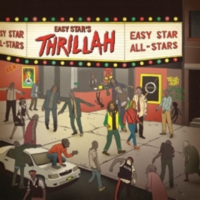
Easy Star All-Stars | Gondwana
Easy Star's Thrillah
Easy Star Records
2012
Ten years ago, the Easy Star All-Stars began a series of albums that transformed landmarks of pop musical culture into thick and easy flowing reggae. They started with Dub Side of the Moon (2003, Easy Star Records) (from Pink Floyd's Dark Side of the Moon), continued through Radiodread (2006, Easy Star) (from Radiohead's OK Computer) and then re-visioned The Beatles' Sgt. Pepper's Lonely Hearts Club Band as Easy Star's Lonely Hearts Dub Band (2009, Easy Star).
But where could the Easy Star All-Stars (ESA) go after John, Paul, George and Ringo? Well, why not one of the biggest and best-selling albums of all time: Thriller, Quincy Jones' masterblaster Michael Jackson production. "For me, I was most excited for Thriller," explains ESA producer, arranger and guitarist Michael Goldwasser. "I was always more of an R&B/soul and reggae kid growing up and I have an intense personal connection to Michael Jackson's music."
"Writing the arrangements for this album was a cool challenge," Goldwasser continues. "I didn't have to try to make non-dance music into dance music as on our previous albums because the original Thriller is so danceable already. I needed to find ways to make each song groove in a different way from the original version. I didn't want any of the arrangements to be obvious in that regard."
Goldwasser arranged and produced sessions in Brooklyn (NY), Tel Aviv (Israel), Sao Paulo (Brazil), Birmingham (UK) and Kingston (Jamaica), and pulled together a genuine village, to complete this tribute. Thrillah centers around the ESA touring band—Goldwasser, keyboardist Elena Canlas, bassist Yossi Fine (David Bowie, Gil Evans, Stanley Jordan) and drummer Joe Tomino (Dub Trio, Matisyahu). Other musicians who climbed onboard include satellite All-Stars Victor Axelrod (Antibalas, Sharon Jones & the Dap-Kings), guitarist Shelton Garner Jr., trombonist Buford O'Sullivan and drummer/percussionist Ivan Katz; percussionist Andy Farag (Umphrey's McGee); and the horn section from Israel's most famous hip-hop funk band, Hadag Nachash. Vocalists Michael Rosen (from Black Uhuru), Luciano and all of Steel Pulse return from Lonely Hearts, Mojo Morgan returns from Radiodread, and Hawaii's reggae export The Green harmonize on "Baby Be Mine."
The best way to dive into Thrillah might be to start with the last two songs: "Dub It," a dub mix of its remade "Beat It," and "Close to Midnight," a cavernous and booming dub of its title track through which horns, guitars, percussion and melodica wash in and out of echo like Vincent Price's ghost.
Properly slowed down and re-spaced, the bass line to the iconic title track "Thriller" transforms into a perfect reggae fulcrum. Vocalists Mikey General and Spragga Benz confidently romp through Jackson's famous vocal and transform Price's horror rap into reggae toasting. Mojo Morgan and Steel Pulse languidly flow through "The Girl Is Mine," Jackson's duet with Paul McCartney.
"The Lady in My Life" and "Billie Jean" are Goldwasser's two most striking rearrangements. He drops most of the accompanying instrumentation and frees vocalist Christopher Martin to delightedly slowdance with "The Lady" dressed in only bass, drums and melodica, which floats like a butterfly trailing behind his vocal. A churning, slightly grungy bass line drives "Billie Jean" to a completely different, more confrontational yet still danceable destination.
Hey, why not Metal Machine Music next?
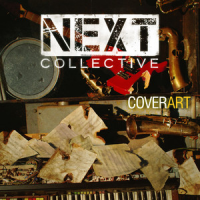
NEXT Collective
Cover Art
Concord Jazz
2013
Cover Art heralds the NEXT Collective: Seven musicians—Logan Richardson (flute and alto saxophone), Walter Smith III (bass clarinet and tenor saxophone), Matthew Stevens (guitar), Gerald Clayton (piano and Fender Rhodes), Kris Bowers (Fender Rhodes), Ben Williams (bass) and Jamire Williams (drums) —whose debut quite capably bears up under the heavy "young lions of jazz" mantle. Bassist Williams won the prestigious 2009 Thelonious Monk International Jazz Competition; drummer Williams has extensively recorded with trumpeter Christian Scott aTunde Adjuah, who guests on several Cover tunes, and he appeared with Stevens on Scott's 2012 landmark Christian aTunde Adjuah (Concord Jazz).
Like Charlie Parker carved out his bebop breakout "Koko" from the chords of the orchestral dance tune "Cherokee," NEXT Collective presents a debut completely assembled from the pop(ular) music of their rock, rap, RnB, hip-hop and pop contemporaries, and even though there's not one "jazz tune" on it, Cover Art is most certainly, and most pleasingly, jazz. It opens with two horns playing simultaneously (another great jazz tradition) atop a rolling snare drum, welcoming the piano that lays down the melody to "Twice" (Little Dragon). The saxophones seem to seek out and connect to the drummer until Stevens' melodic guitar lines tie the entire tune together.
Many tunes powerfully drive into straight-ahead jazz, but other covers steer down slightly different paths. "Africa" (D'Angelo) refocuses the skeletal original's digital funk around its softly downward keyboard spiral to createa smooth and mellow jazz piece. Drummer Williams rocks "Come Smoke My Herb" (Meshell Ndegeocello) hard and mighty, his emphatic tumult pushing the saxophonists higher and higher. Adorned in gentle flute and acoustic piano, "Refractions in the Plastic Pulse" (Stereolab) sounds more organic than plastic as it grows from and then floats above the rhythm section's fertile bed, and "Oceans" (Pearl Jam) and "Perth" (Bon Iver) are remodeled into harmonic moods that float through suspended time.
Scott's trumpet turns burn with pure star quality. His hot howling wind uses the symmetrical piano/bass underrhythm as kindling to set "No Church in the Wild" (Jay Z & Kanye West) on fire. The somber shades of "Marvin's Room" (Drake) allows Scott to channel the starkly dark, profound melancholy of Miles Davis (through Davis' breathy and worn yet regal "Time After Time" sound) as he lightly tosses on drummer Williams' quicksilver, post-hip-hop waves, ornamented by acoustic piano like the starlight of a perfectly silent night.
Tracks and Personnel:
Show of Strength
Tracks: Count on You; Take a Chance on Me, Baby; Storm Warning; Can You Read Between the Lines?; Cross Eyed Woman; Little Juke Joint; 24 Hour Blues; Valley of Tears; Since I Been Loving You; I Want to Get You Back; What Does It Take to Please You?; Feel Like Going Home.
Personnel: Michael Burks: guitars, vocals; Wayne Sharp: organ, piano, background vocals; Terrence Grayson: bass, background vocals; Chuck "Popcorn" Louden: drums, background vocals; Roosevelt Purifoy: keyboards; Scott Dirks: harmonica.
The Miles Davis Quintet—Live in Europe 1969: The Bootleg Series Vol. 2
Tracks: CD1: Introduction; Directions; Miles Runs the Voodoo Down; Milestones; Footprints; 'Round Midnight; It's About That Time; Sanctuary; The Theme; CD2: Introduction; Directions; Spanish Key; I Fall in Love Too Easily; Masqualero; Miles Runs the Voodoo Down; No Blues; Nefertiti; Sanctuary; The Theme; CD3: Introduction; Bitches Brew; Paraphernalia; Nefertiti; Masqualero; This; DVD: Introduction; Directions; Bitches Brew; It's About That Time; I Fall In Love Too Easily; Sanctuary; The Theme.
Personnel: Miles Davis: trumpet; Wayne Shorter: tenor saxophone, soprano saxophone; Chick Corea: electric piano, acoustic piano; Dave Holland: bass; Jack DeJohnette: drums.
Easy Star's Thrillah
Tracks: Wanna Be Startin' Something (featuring JoWil and Ruff Scott); Baby Be Mine (featuring The Green); The Girl is Mine (featuring Mojo Morgan and Steel Pulse); Thriller (featuring Mikey General and Spragga Benz); Beat It (featuring Michael Rose); Billie Jean (featuring Luciano); Human Nature (featuring Cas Haley); P.Y.T (Pretty Young Thing, featuring Kirsty Rock); The Lady in My Life (featuring Christopher Martin); Dub It; Close to Midnight.
Personnel: Michael Godwasser: guitars, clavinet, synthesizer, percussion, melodica, glockenspiel, backing vocals, programming; Yossi Fine: bass; Joe Tomino: drums, synaire; Elenna Canlas: piano, organ, electric piano, synthesizer, clavinet, backing vocals; Victor Axelrod: clavinet, organ; Shlomi Alon: tenor saxophone, baritone saxophone; Yair Slutzki: trombone; Sefi Zisling: trumpet; Andy Farag: percussion; Gavriel Friesem: percussion, binghi drumming; Shelton Garner, Jr.: guitar, backing vocals; Ivan Katz: drums, electric drums; Amit Sagie: guitar, binghi drumming; Buford O'Sullivan: trombone; Jenny Hill: tenor saxophone; Wayne Wiggum: synthesizer; Kirsty Rock: backing vocals; Joanne Williams: backing vocals; Paul Schellack: backing vocals; Tali Goldwasser: backing vocals; Simone Smith: backing vocals.
Cover Art
Tracks: Twice (Little Dragon); No Church in the Wild (Jay Z and Kanye West); Africa (D'Angelo); Fly or Die (N.E.R.D.); Oceans (Pearl Jam); Refractions in the Plastic Pulse (Stereolab); Marvin's Room (Drake); Come Smoke My Herb (Meshell Ndegeocello); Perth (Bon Iver); Thank You (Dido).
Personnel: Logan Richardson: alto saxophone, flute; Walter Smith III: bass clarinet, tenor saxophone; Matthew Stevens: guitar; Gerald Clayton: piano, Fender Rhodes; Kris Bowers: Fender Rhodes; Ben Williams: bass; Jamire Williams: drums; Christian Scott: trumpet.
< Previous
Number Stations
Next >
The View From Here
Comments
Tags
From the Inside Out
Chris M. Slawecki
United States
Johnnie Taylor
Eric Clapton
albert king
Jimi Hendrix
Miles Davis
Wayne Shorter
Chick Corea
Dave Holland
Jack DeJohnette
Easy Star All-Stars
Pink Floyd
The Beatles
Quincy Jones
Michael Jackson
Gil Evans
Stanley Jordan
Dub Trio
Antibalas
the Dap-Kings
Umphrey's McGee
Michael Rose
Luciano
Steel Pulse
Paul McCartney
Logan Richardson
Walter Smith III
Matthew Stevens
Gerald Clayton
Kris Bowers
Ben Williams
Jamire Williams
Thelonious Monk
CHRISTIAN SCOTT
Charlie Parker
D'angelo
Meshell Ndegeocello
Pearl Jam
Drake
For the Love of Jazz
 All About Jazz has been a pillar of jazz since 1995, championing it as an art form and, more importantly, supporting the musicians who create it. Our enduring commitment has made "AAJ" one of the most culturally important websites of its kind, read by hundreds of thousands of fans, musicians and industry figures every month.
All About Jazz has been a pillar of jazz since 1995, championing it as an art form and, more importantly, supporting the musicians who create it. Our enduring commitment has made "AAJ" one of the most culturally important websites of its kind, read by hundreds of thousands of fans, musicians and industry figures every month.






